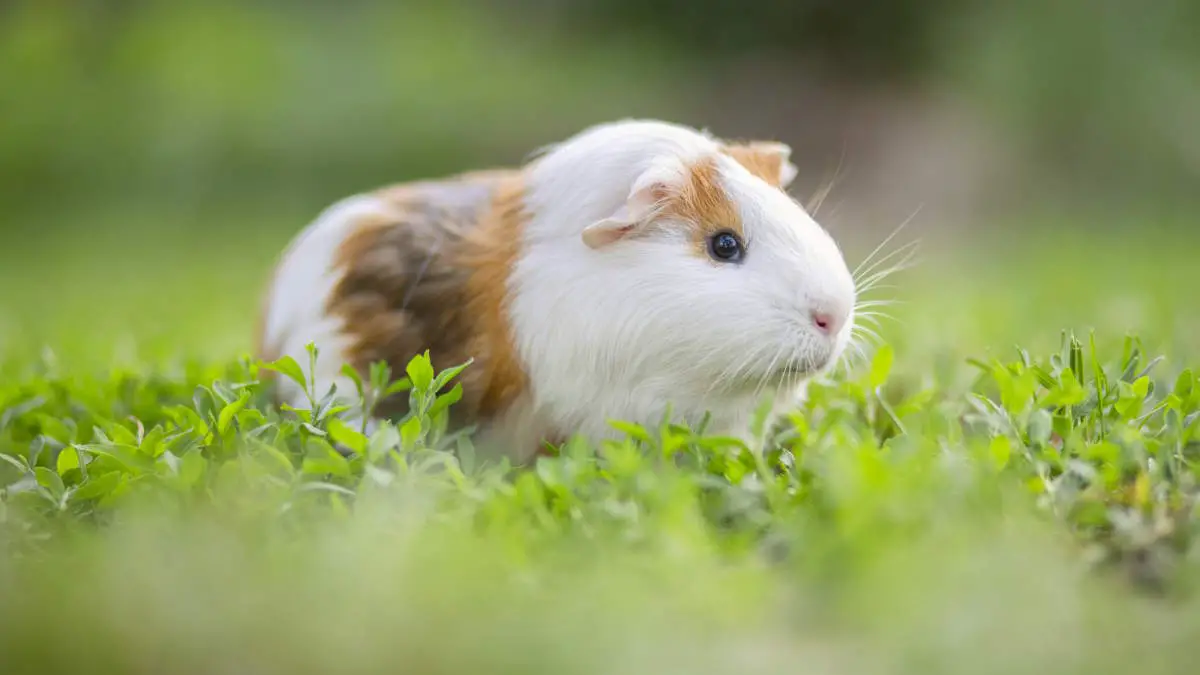Animals can sometimes have misleading names and carry titles that either exaggerate their features, misrepresent their behavior or habitat, or simply confuse them with entirely different species. Here are the top 15 animals known for their misleading names:
1. Guinea Pig
Neither a pig nor from Guinea.
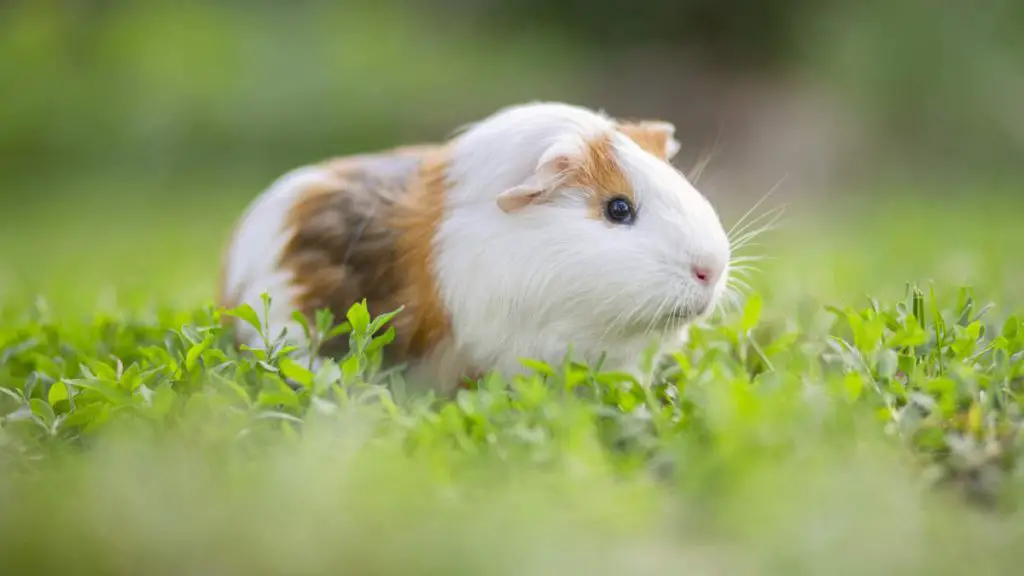
Despite its name, the guinea pig is not a pig and is not from Guinea. It is a rodent from the Andes in South America. Known scientifically as Cavia porcellus, it is an animal whose common name is quite misleading in several ways:
- Not from Guinea: Despite the name, Guinea Pigs are not from Guinea or any part of Africa. They are native to the Andes region of South America. The origin of the “Guinea” in their name is unclear, but it may have been derived from a misassociation with the region of Guinea in West Africa, possibly due to the animals being transported via ships that might have stopped there.
- Not a Pig: Guinea Pigs are not pigs, nor are they closely related to them. They belong to the rodent family, specifically the Caviidae family, which also includes capybaras and maras. Their name might come from their pig-like appearance and sounds (they often make a squealing noise similar to that of a pig), but biologically, they are quite different from pigs.
- Domestication and Use: Guinea Pigs were domesticated as early as 2000 BC in South America. They were kept not only as pets but also for religious ceremonies and as a source of food. The practice of keeping guinea pigs as pets became popular in Europe after their introduction by European traders.
- Physical Characteristics: Guinea Pigs are small, stout-bodied rodents with no tail. They have a large head relative to their body, rounded ears, and short legs. Their fur can be a variety of colors and they are known for their social and docile nature.
- Role in Research: The term “guinea pig” is also widely used metaphorically in English to refer to a subject being used for experimental tests. This usage stemmed from the extensive use of guinea pigs in scientific research and experimentation, although other animals like mice and rats are more commonly used today.
2. Koala Bear
Not a bear.
Koalas are not bears but marsupials. They are more closely related to kangaroos and wombats.

- Not a Bear: Despite its name, the Koala is not a bear. It’s a marsupial, which is a different category of mammals. Marsupials, like kangaroos and wallabies, are distinguished by their reproductive process: they give birth to underdeveloped young that complete their development in a pouch on the mother’s body.
- Origins of the Name: The “bear” part of its name likely comes from its superficial resemblance to teddy bears, especially in the facial features. Early European settlers in Australia might have named them based on this resemblance, not being familiar with marsupials.
- Physical and Behavioral Characteristics: Koalas are known for their stout, tailless body and large head with round, fluffy ears and a large, spoon-shaped nose. They are arboreal, spending most of their time in eucalyptus trees, and they have a diet that is almost exclusively eucalyptus leaves.
- Habitat: Koalas are native to Australia and are primarily found in the eastern and southern regions of the continent. They live in eucalyptus forests and woodlands where they can find their food source.
- Conservation Status: Koalas are facing numerous threats, including habitat destruction due to urbanization and agriculture, bushfires, and diseases like Chlamydia. Their conservation status varies by region but has been a growing concern in recent years.
- Cultural Significance: The Koala is an iconic animal in Australia and has become a symbol of the country’s unique wildlife. It also plays a significant role in Australian cultural identity and conservation efforts.

Related: 10 Amazing Koala Facts
3. Electric Eel
Not an eel.
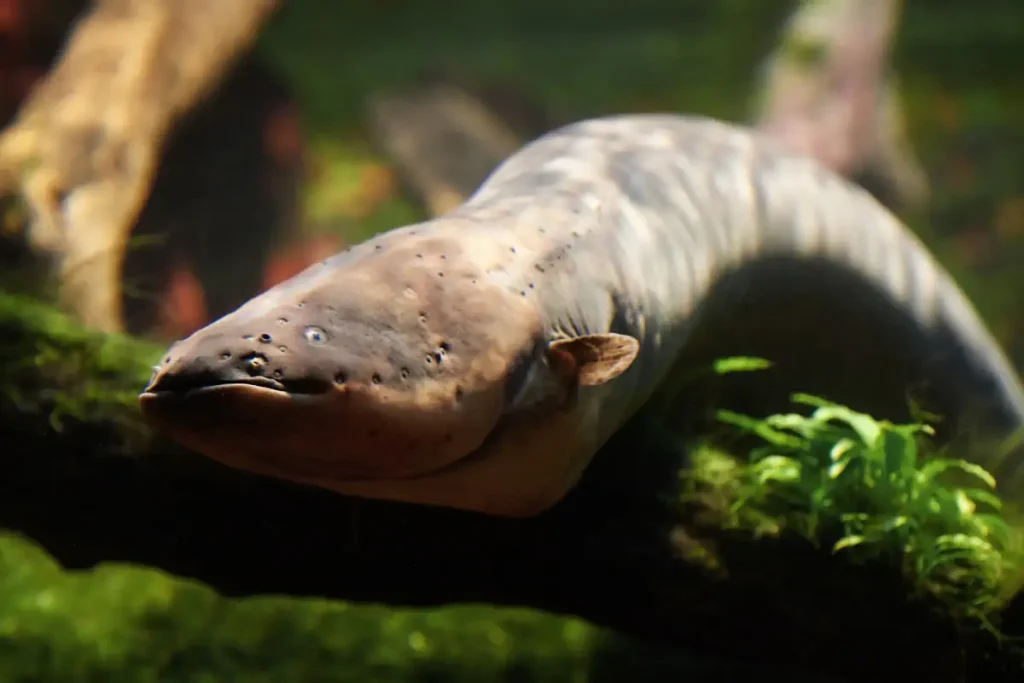
The “Electric Eel” is an intriguing case of a misnomer in the animal kingdom:
- Not an Eel: Despite its name, the Electric Eel is not a true eel. It belongs to the knifefish family and is more closely related to catfish than to the eels found in the order Anguilliformes.
- Electric Ability: The name ‘electric’ is, however, very apt. Electric Eels are known for their extraordinary ability to generate powerful electric shocks. They use this ability for hunting, self-defense, and navigation. They can produce electric discharges of up to 600 volts, which is significant enough to stun prey and deter predators.
- Physical Appearance: The Electric Eel has a long, cylindrical body that resembles that of a typical eel, which likely contributed to its common name. However, unlike true eels, electric eels have a squared tail and a flattened head.
- Habitat: Electric Eels are found in freshwater habitats in South America, particularly in the Amazon and Orinoco River basins. They thrive in muddy, slow-moving waters.
- Behavior and Diet: Electric Eels are nocturnal and have poor eyesight; they rely heavily on their electric fields for navigation and hunting. Their diet mainly consists of fish, amphibians, and occasionally birds and small mammals.
- Reproduction: Unlike many fish, electric eels are known for their interesting breeding behavior, where the male creates a nest from his saliva for the female to lay eggs.
4. King Cobra
Not a cobra.

- Not a True Cobra: The King Cobra (Ophiophagus hannah) is not a true cobra in the sense of belonging to the Naja genus, which includes most cobra species. Instead, it is the sole member of its own genus, Ophiophagus, which means “snake-eater” in Greek.
- Why “King”?: The “king” in its name refers to its status as a predator of other snakes, including true cobras. The King Cobra is renowned for its ability to hunt and consume other venomous and non-venomous snakes.
- Physical Characteristics: King Cobras are the world’s longest venomous snakes, reaching lengths of up to 18 feet (5.5 meters). They have a distinctive hood, similar to true cobras, which they flare when threatened or displaying aggression.
- Venom Potency and Hunting Behavior: While not the most venomous snake, the King Cobra’s venom is extremely potent. Its hunting strategy relies on delivering a large volume of venom to quickly immobilize and kill its prey.
- Habitat and Range: King Cobras are found predominantly in forests from India through Southeast Asia to the Philippines and Indonesia. They prefer habitats such as dense highland forests, bamboo thickets, and mangrove swamps.
- Cultural Significance: The King Cobra holds a significant place in the culture and folklore of many countries where it is found. It is often revered and feared, playing a key role in various cultural and religious beliefs.
- Conservation Status: The King Cobra is listed as vulnerable due to habitat destruction, poaching, and persecution. Conservation efforts are vital for the survival of this iconic species.

Related: 10 Amazing King Cobra Facts
5. Flying Fox
Not a fox.
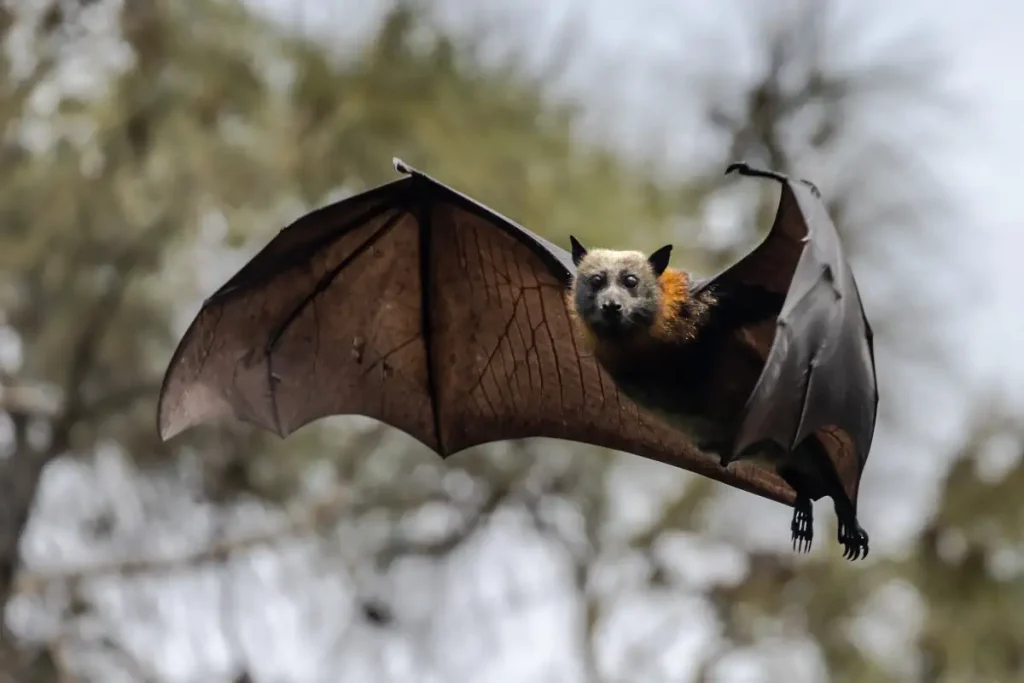
- Not a Fox: Despite the name, Flying Foxes are not foxes. They are actually large bats belonging to the Pteropus genus, which is the largest genus of bats in the world. The term “fox” in their name likely comes from their fox-like facial appearance, including pointed snouts and large eyes.
- Flying Capabilities: While they are called “flying,” Flying Foxes don’t fly in the same way birds do. Their flight involves gliding and flapping using their webbed wings, which are actually modified forelimbs. This mode of flight is typical of all bats.
- Physical Characteristics: Flying Foxes are known for their large size, with some species having a wingspan of up to 1.5 meters (5 feet). They have a furry body, sharp claws, and large eyes that give them excellent night vision.
- Diet and Behavior: These animals are primarily frugivorous, meaning they mainly eat fruit, along with nectar and flowers. They play a crucial role in their ecosystems as pollinators and seed dispersers.
- Habitat: Flying Foxes are found in tropical and subtropical regions of Asia, Australia, East Africa, and some oceanic islands in the Indian and Pacific Oceans. They roost in trees and are often seen in large groups.
- Conservation Concerns: Many species of Flying Foxes are threatened by habitat loss, hunting, and other human activities. Their roosting and foraging habitats, often near human settlements, have made them susceptible to conflict with humans.
6. Mountain Lion
Not a lion. Not even a panther.
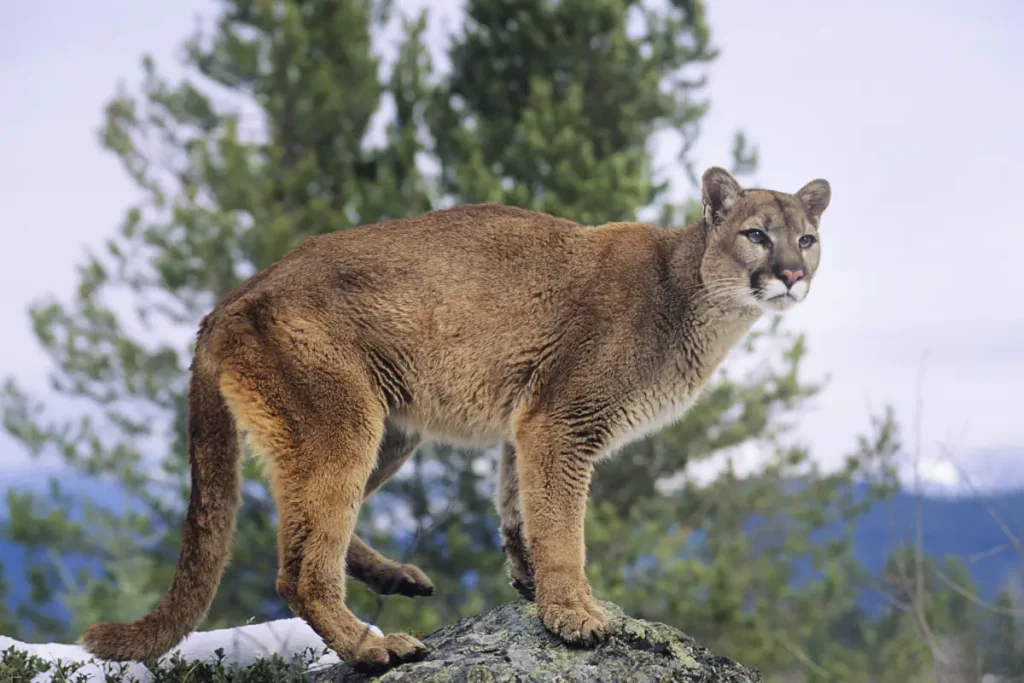
The “Mountain Lion” is another animal with a somewhat misleading name:
- Not a Lion: The Mountain Lion (Puma concolor), also known as the cougar, puma, or (erroneously) panther, is not a lion. It’s actually more closely related to smaller felines including the domestic house cat than to lions or other big cats like tigers and leopards.
- Wide Range of Habitats: Although named “mountain lions”, these animals are found in a variety of habitats beyond just mountainous areas. They inhabit forests, prairies, deserts, and wetlands, showing a remarkable adaptability to different environments.
- Physical Characteristics: The Mountain Lion is a large, solitary cat with a tan or slightly yellow coat, akin to a lion’s, but it lacks a mane. It is the second-largest cat in the Americas, after the jaguar.
- Behavior and Diet: As apex predators, they are territorial and primarily nocturnal. Their diet mainly consists of deer, but they also prey on smaller animals when necessary.
- Distribution: They have the most extensive range of any wild terrestrial mammal in the Western Hemisphere, covering large areas of North and South America.
- Conservation and Human Interaction: While not currently considered endangered, Mountain Lions face threats from habitat loss and fragmentation. Their interactions with humans can be contentious, particularly in areas where human populations encroach on their territories.
.
7. Maned Wolf
Not a wolf.

- Not a Wolf: The Maned Wolf is not a true wolf, nor is it closely related to other wolves. It belongs to the genus Chrysocyon (meaning “golden dog”) rather than Canis, which includes true wolves.
- Physical Appearance: Its name comes from its striking appearance, which includes a mane on the back of its neck that can be raised when the animal feels threatened or is displaying aggression. This mane, combined with its long, stilt-like legs and reddish-brown fur, gives it a somewhat wolf-like appearance, hence the name.
- Unique Canid Species: The Maned Wolf is the largest canid of South America and is the only species in its genus. Its physical and behavioral characteristics are quite distinct from those of wolves. For example, it has longer legs relative to its body size than most other canids, which is an adaptation to the tall grasslands of its native habitat.
- Diet and Habitat: Unlike true wolves, which are known for hunting large prey, the Maned Wolf has a more omnivorous diet. It eats a variety of foods, including small mammals, birds, and even significant amounts of plant matter, such as fruits.
- Geographical Distribution: The Maned Wolf is native to South America and is particularly found in open and semi-open habitats in Brazil, Paraguay, Argentina, Bolivia, and Peru. This distribution is quite different from that of true wolves, which are primarily found in North America and Eurasia.
8. Mountain Chicken
Not a chicken. Not even a bird.
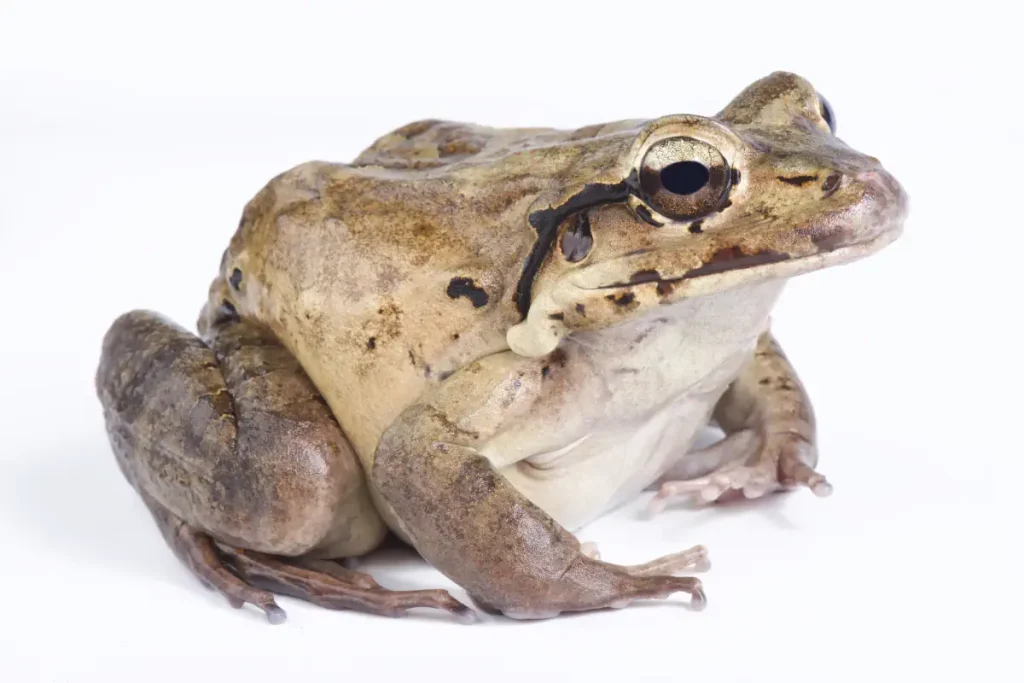
The “Mountain Chicken” is a particularly interesting case of an animal with a misleading name:
- Not a Chicken: The Mountain Chicken is not a chicken or any kind of bird. It is actually a frog, specifically the Leptodactylus fallax, a species of frog native to the Caribbean.
- Why “Mountain Chicken”?: The name “Mountain Chicken” comes from its traditional use as a food source. The frog was once a popular delicacy in its native habitat, particularly on the islands of Dominica and Montserrat. It’s said to taste similar to chicken, which is how it got its unusual name.
- Physical Characteristics: The Mountain Chicken is one of the largest frogs in the world, with females being larger than males. They have robust bodies and are typically brown or grayish-brown in color.
- Habitat: Despite the “mountain” in its name, these frogs are not exclusively mountain dwellers. They are found in a variety of habitats, including forests, near rivers, and in more arid environments.
- Behavior and Diet: The Mountain Chicken is a nocturnal predator, feeding mainly on insects, small mammals, and other smaller frogs. They are known for their loud, distinctive calls, which are used for communication during the breeding season.
- Conservation Status: The Mountain Chicken is critically endangered, primarily due to habitat loss, hunting, and a devastating fungal disease called chytridiomycosis. Conservation efforts are underway to protect and preserve the remaining populations.
9. Horned Toad
Not a toad.

- Not a Toad: The Horned Toad is not actually a toad, but a lizard. It belongs to the genus Phrynosoma, which is part of the family Phrynosomatidae. The misnomer comes from its rounded body and toad-like shape, but biologically, it is quite different from actual toads.
- Horns and Appearance: The “horned” part of its name is accurate. These lizards have a distinctive appearance with spiny projections on their head and body, which resemble horns. This unique morphology is an adaptation for defense and camouflage.
- Habitat and Distribution: Horned Toads are native to North America and are particularly found in arid and semi-arid environments. Their habitats range from deserts to grasslands.
- Diet and Lifestyle: Contrary to what one might expect from a toad, Horned Toads primarily feed on ants, although they also consume other small insects. Their specialized diet and hunting tactics are adapted to their environment.
- Behavioral Traits: These lizards are known for their ability to puff up their bodies as a defensive mechanism to appear larger and more threatening to predators. Some species are also capable of squirting blood from their eyes as a defense against predators.
- Conservation Status: Many species of Horned Toads are facing threats due to habitat loss, invasive species, and environmental changes. As a result, several species are listed as threatened or endangered in different regions.
10. Sea Cucumber
Not a cucumber. It is an animal, not a plant.

- Not a Cucumber: Despite its name, the Sea Cucumber is not a vegetable or plant, but an animal. It belongs to a group of marine animals known as echinoderms, which also include starfish and sea urchins.
- Physical Appearance: The name “Sea Cucumber” comes from the animal’s elongated, cylindrical shape that resembles a cucumber. They have a leathery skin and an elongated body.
- Habitat and Diversity: Sea Cucumbers are found in a variety of marine environments, from shallow to deep sea beds. There are over 1,250 known species, and they are found in oceans worldwide.
- Feeding and Behavior: These creatures are scavengers and play a significant role in ocean ecosystems. They feed on detritus and other organic matter, breaking down this material and recycling nutrients back into the ecosystem.
- Defense Mechanisms: Some species of sea cucumbers have unique defense mechanisms. When threatened, they can expel their internal organs to confuse predators and then regenerate these organs later. Others can release toxic substances or sticky threads to deter predators.
- Culinary and Medicinal Uses: In some cultures, particularly in Asia, sea cucumbers are considered a delicacy and are also used in traditional medicine. They are harvested for food, a practice that has led to overfishing and sustainability concerns in some regions.
- Ecological Importance: Sea cucumbers play a crucial role in the health of marine ecosystems, particularly in coral reefs. They help maintain the ocean’s nutrient cycle and assist in keeping the sea floor sediment healthy and oxygenated.
11. Prairie Dog
Not a dog.
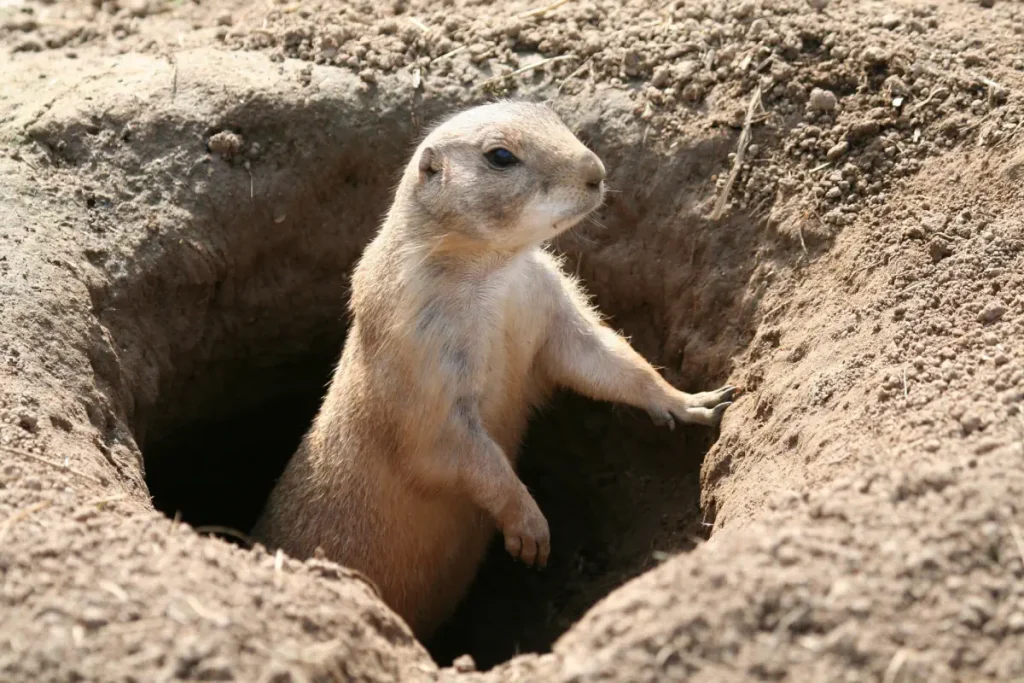
The “Prairie Dog” is another example of an animal with a somewhat misleading name:
- Not a Dog: Despite its name, the Prairie Dog is not a dog. It is actually a type of rodent. Prairie Dogs belong to the genus Cynomys in the squirrel family (Sciuridae), making them relatives of squirrels, chipmunks, and marmots.
- Reason for the Name: The “dog” part of their name likely comes from their bark-like call, which resembles the sound of a small dog’s bark. This vocalization is used to communicate various alerts and messages within their colonies.
- Physical Characteristics: Prairie Dogs are small, stout rodents with short legs and short tails. They have a brownish fur that helps them blend into their prairie environment.
- Habitat and Lifestyle: True to their name, Prairie Dogs are found in the prairies and grasslands of North America, particularly in the United States, Canada, and Mexico. They live in large colonies or “towns” that can cover many acres of land with their complex underground burrow systems.
- Social Structure: They are highly social animals and live in closely-knit family groups within their colonies. Their social behaviors are sophisticated and include a complex system of vocal communication.
- Ecological Role: Prairie Dogs play a crucial role in their ecosystem. Their burrowing activity helps to aerate the soil and increase water penetration. They are also an important food source for a variety of predators.
- Conservation Status: Some species of Prairie Dogs have been classified as threatened due to habitat loss and disease. Their presence can be controversial due to their impact on agricultural land, leading to efforts to control their populations in some areas.
12. Red Panda
Not a panda.
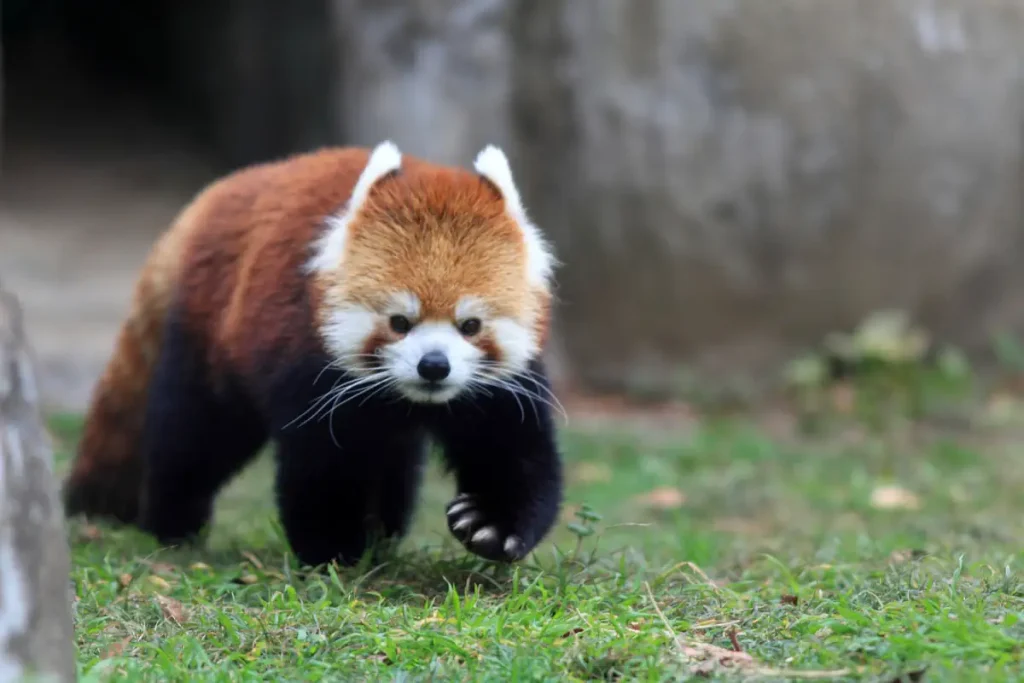
- Not a Panda: The Red Panda (Ailurus fulgens) is not closely related to the giant panda. While both share a name and have some dietary similarities (like eating bamboo) and somewhat similar body posture, they belong to different families. The Red Panda is the only species in its family, Ailuridae, whereas the giant panda is in the bear family, Ursidae.
- Why “Red”?: The name “Red Panda” is derived from their reddish-brown fur, which provides excellent camouflage in the red-brown moss and lichen-covered trees of its habitat.
- Physical Characteristics: The Red Panda is much smaller than the giant panda, resembling a raccoon in size and appearance, with a long, bushy tail that it uses for balance and to cover itself in winter.
- Habitat and Range: Red Pandas are native to the eastern Himalayas and southwestern China. They live in high-altitude temperate forests with dense canopies and a bamboo understory.
- Diet and Behavior: Although bamboo constitutes the majority of their diet, Red Pandas are omnivores. They also eat fruits, acorns, roots, and eggs. Unlike the giant panda, which is almost entirely herbivorous, the Red Panda supplements its diet with a variety of foods.
- Conservation Status: The Red Panda is classified as endangered due to habitat loss, fragmentation, poaching, and the impact of climate change. Their natural habitat is shrinking due to deforestation and other human activities.
- Cultural Significance: The Red Panda is an important animal in the cultures of the Himalayan region and is often featured in folklore and art. It is also a charismatic species that plays a significant role in wildlife conservation efforts.
13. Peacock Mantis Shrimp
Neither a peacock nor a mantis, nor a traditional shrimp.
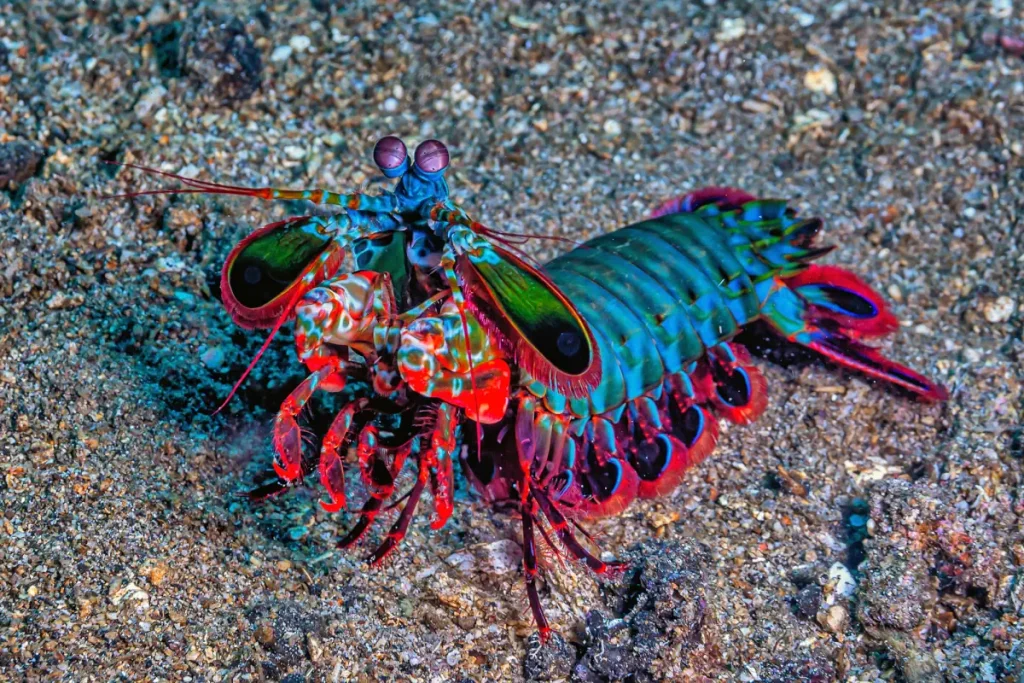
The Peacock Mantis Shrimp, or Odontodactylus scyllarus, is another great example of an animal with a misleading name. Despite what its name suggests, it is neither a peacock nor a mantis, nor a traditional shrimp. Here’s why its name can be misleading:
- “Peacock”: This part of its name refers to the bright, vibrant colors that adorn its body, reminiscent of the plumage of a peacock. The Peacock Mantis Shrimp is known for its striking colors which are used for communication and possibly camouflage in its natural habitat.
- “Mantis”: The term “mantis” in its name comes from its resemblance to praying mantises, particularly in the structure and use of its raptorial appendages (forelimbs), which it uses to capture prey. These limbs are incredibly powerful and can strike with the velocity of a bullet from a gun, making them formidable predators in their marine environment.
- “Shrimp”: While it is a crustacean, the Peacock Mantis Shrimp is not a shrimp in the traditional sense. It belongs to the order Stomatopoda, which is separate from the decapods that include true shrimps, lobsters, and crabs. Mantis shrimps are known for their unique hunting tactics and complex eyes, which are among the most sophisticated visual systems in the animal kingdom.
So, while its name implies a combination of three different creatures (peacocks, mantises, and shrimps), the Peacock Mantis Shrimp is actually a distinct species with its own unique characteristics and behaviors.
14. Flying Lemur
Neither a lemur nor does it fly.

The “Flying Lemur,” also known as the Colugo, is an animal with a misleading name in several respects:
- Not a Lemur: Despite its name, the Flying Lemur is not a lemur nor is it closely related to lemurs, which are primates found in Madagascar. Colugos belong to the order Dermoptera and are more closely related to primates than to any other groups, but they are not primates themselves.
- Gliding, Not Flying: The term “flying” is a bit of a misnomer. Colugos cannot fly like birds or bats. Instead, they are skilled gliders. They have a large membrane of skin that stretches between their limbs and tails, which they use to glide long distances between trees. This adaptation is perfect for moving through the treetops of their forest habitats.
- Physical Appearance and Habitat: Colugos have a unique appearance with large, forward-facing eyes and a small head. They are primarily found in Southeast Asia, including the Philippines, Malaysia, Indonesia, and Thailand. Their habitat is typically in tropical rainforests.
- Diet and Behavior: Colugos are herbivorous and feed on soft plant parts like leaves, flowers, and fruits. They are nocturnal animals, spending most of the day resting in tree hollows or under large tree branches, coming out at night to feed and glide between trees.
- Conservation Status: The two species of colugo, the Sunda Flying Lemur and the Philippine Flying Lemur, face threats from habitat destruction and fragmentation. While not currently listed as endangered, their populations are affected by deforestation in Southeast Asia.
15. Tasmanian Devil
Not a devil 🙂
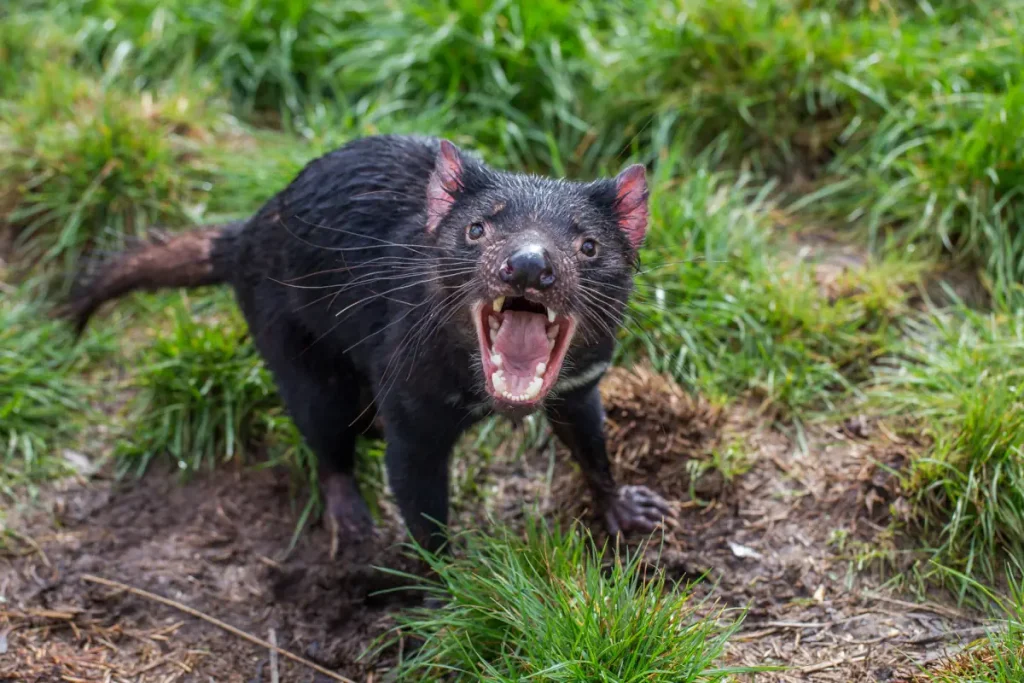
- Not a Devil: The Tasmanian Devil (Sarcophilus harrisii) is not, of course, a devil in any mythological or supernatural sense. Its intimidating name likely comes from the ferocious appearance and behavior it displays, especially when feeding or threatened. Early European settlers in Tasmania named it after its loud, disturbing screeches, growls, and aggressive nature.
- Physical Characteristics: The Tasmanian Devil is a marsupial, which means it carries its young in a pouch. It’s the largest carnivorous marsupial following the extinction of the Thylacine, or Tasmanian Tiger. Tasmanian Devils have a stocky build, with a large head and a short, thick tail.
- Habitat and Behavior: As the name suggests, they are native to the Australian island state of Tasmania. They are primarily nocturnal and spend their days in dense bush or in a burrow. Devils are known for their powerful jaws and ability to consume a wide variety of food, including carrion.
- Diet: They are opportunistic feeders and play an important role in the ecosystem as scavengers. Their diet includes birds, fish, insects, and carrion. They have incredibly strong jaws and teeth that allow them to crush bones and consume almost all parts of their prey.
- Conservation Status: The Tasmanian Devil is currently listed as endangered. They have faced a significant population decline primarily due to a contagious cancer known as Devil Facial Tumour Disease (DFTD), which has drastically impacted their numbers.
- Cultural Impact: The Tasmanian Devil has become an iconic symbol of Tasmania and Australian wildlife. It’s also known worldwide due to the popular Looney Tunes cartoon character “Taz”, although this representation is highly exaggerated and fictional.
Sources
- Guinea Pig on Wikipedia
- Koala on Wikipedia
- Electric Eel on Wikipedia
- “King Cobra, facts, and photos” on the National Geographic website
- “Flying Fox: Size, Diet, & Facts” on the Encyclopedia Britannica website
- Mountain Lion on the National Wildlife Federation website
- Maned Wolf on the Smithsonian’s National Zoo website
- Mountain Chicken on the Endangered Wildlife website
- Horned Lizard on Wikipedia
- “Sea cucumber: Echinoderm Anatomy & Adaptations” on the Encyclopedia Britannica website
- “8 surprising prairie dog facts” on the World Wildlife Fund website
- Red Panda on Wikipedia
- Peacock Mantis Shrimp on the National Aquarium website
- Flying Lemur on the Encyclopedia Britannica website
- Tasmanian Devil on the Australian Museum website
- Moon Landings: All-Time List [1966-2025] - February 2, 2025
- What Is Max-Q and Why Is It Important During Rocket Launches? - January 16, 2025
- Top 10 Tallest Rockets Ever Launched [2025 Update] - January 16, 2025
